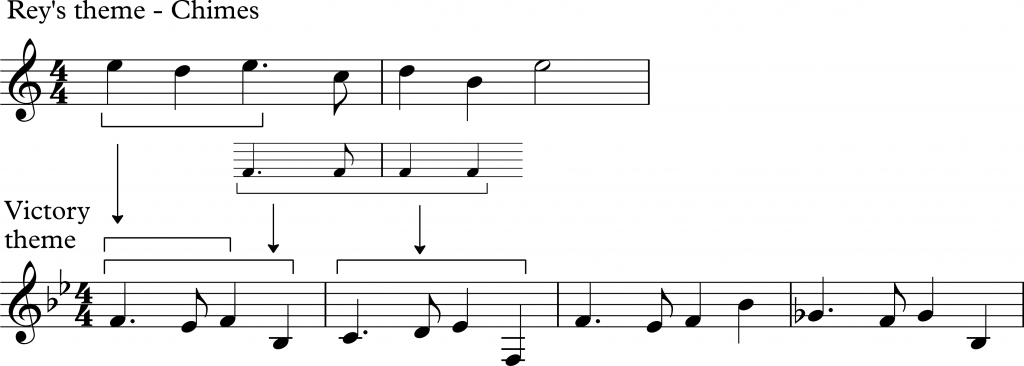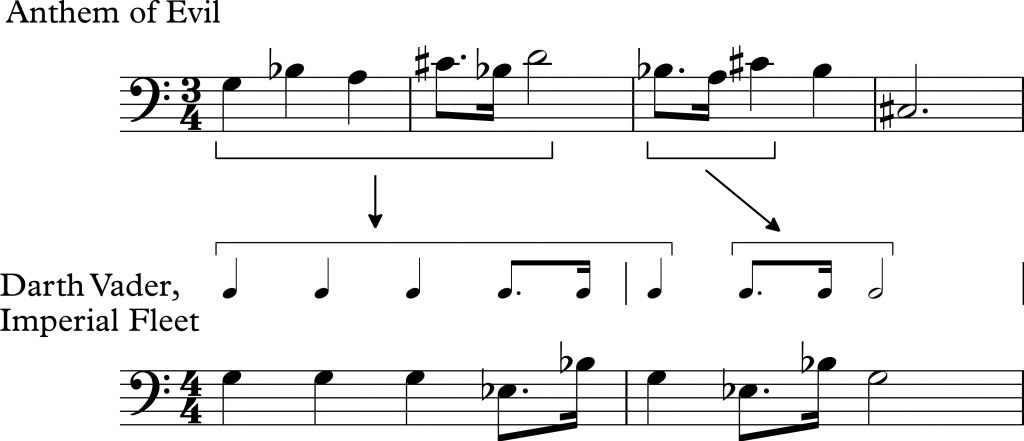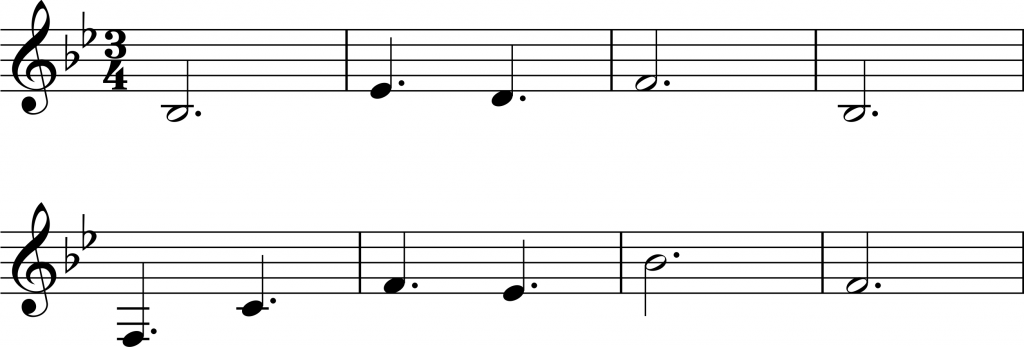
With The Rise of Skywalker, John Williams has brought his scoring of the nine-film Star Wars saga to a conclusion. As with each sequel in the saga, Williams added several new themes to the musical collection while recalling and building on many earlier ones as well. To appreciate just how large this collection has become, one need only peruse music theorist Frank Lehman’s majesterial thematic catalogue which, along with listing each theme, offers a host of musical Star Wars goodies. The analysis I present below will offer interpretations of the five new themes that appear most prominently in The Rise of Skywalker: Victory, Friendship, Anthem of Evil, the Knights of Ren, and Poe’s Heroics.
Victory

This theme appears in the latter portions of the film when the Resistance is planning for and achieving the defeat of the First Order. It has strong connections to two other themes in the saga. First, and perhaps most obviously, it recalls what I called in an earlier post Rey’s Chimes motif – one of the introductory portions of her theme. Below, see and hear how the opening step-down/step-up figure and the slow dotted rhythm plus stately quarter notes in Rey’s Chimes also appear in the Victory theme.

Rey’s Chimes
More hidden, however, is an allusion to Luke’s theme (the main theme of the saga). After the “Chimes” reference in the first three notes comes the first six notes of Luke’s theme, stated in an inversion! See below for a comparison.

In the film, the most prominent statement of this theme occurs when the Resistance has defeated the First Order, after Rey has led the Resistance to the Emperor’s new fleet and defeated the Emperor and therefore all the Sith (whom the Emperor himself claims to be). The references in this theme neatly punctuate this point: although the entire nine-film series (except for Return of the Jedi, which in the context of The Rise of Skywalker, is only a partial ending) has seen evil triumph over good, now Rey has flipped the situation around and brought about the final triumph of good over the evil of the saga (see below). Williams depicts this musically through a combination of Rey’s Chimes and an inversion of Luke’s theme – the main theme of the entire series.

Friendship

This is the most pervasive new theme in The Rise of Skywalker, appearing mainly in moments of bonding between or among members of the Resistance. The theme’s most characteristic feature is the raised 4th degree of the Lydian mode in both the melody and the accompanying harmony in its use of the major II chord.[1] Williams has drawn on the Lydian mode for a handful of other themes from the Star Wars saga, most memorably in Yoda’s theme, but also in the boy Anakin’s theme, Rose’s theme, and a victorious fanfare from Return of the Jedi. The Lydian mode is similar to the major scale, but its raised 4th degree tends to increase the positive associations of the major scale. The result is an emotional state that is both ultra-positive and out of the ordinary, which helps to explain why Williams has employed the Lydian mode in his Star Wars music for unusual examples of purity (Anakin and Rose), wisdom (Yoda), victory, or in this case, deep friendship.
Anthem of Evil

One might ask why The Rise of Skywalker needed a new bad-guy theme when the saga already has one for Darth Vader and the Imperial fleet, one for the Emperor, and two for Kylo Ren. One possible answer is in the unique ways in which this ninth film combines these three villains together. For one, Ren’s behaviour more closely matches that of Vader than ever before: not only does he reforge his Vader-like mask, but he also becomes an assistant to the Emperor with thoughts of overthrowing him, and attempts to turn Rey to the Dark Side as Vader attempted with Luke. Also, when the Anthem of Evil appears, it accompanies actions that are combinations of Ren, Vader or the new fleet of Star Destroyers, and the Emperor, as outlined below:
- Ren flies to Exegol at the start of the film to find the Emperor Ren + Emperor
- Ren offers his hand to Rey after telling her she’s a Palpatine Ren + Vader
- To find Exegol, Ren tries to coerce Rey to join the Dark Side Ren + Vader
- A Star Destroyer blows up Kijimi upon the Emperor’s order Emperor + Fleet
- Rey arrives at Exegol among the thousands of Star Destroyers Emperor + Fleet
With all this in mind, it becomes clear why a new evil theme is an appropriate choice. The Anthem of Evil expresses these combinations of evil musically by incorporating aspects of all three villians’ music. The opening two notes form a rising minor 3rd, the defining interval of the Emperor’s theme. Although the reference is short, its placement at the start of the theme gives it a prominence that is hard to miss, especially in the context of the evil combinations in the film.
In terms of the pitch material, the theme uses the same degrees of the Hungarian minor scale as Kylo Ren’s “aggressive” theme with its highly characteristic raised 4 degree of the scale. As shown below, the Anthem of Evil adds scale degree 2 as well, but with the majority of notes falling on the tonic minor chord and raised 4 degree, the theme can still be clearly heard as strongly related to Ren’s main theme.

Finally, the Anthem of Evil also has a rhythmic resemblance to Darth Vader’s theme, the Imperial March (see below). This allusion is more hidden for two reasons. First, the sixth note is given a longer length before the theme continues the Vader rhythm where it left off. Second, the rhythm is set in an off-balance and somewhat ambiguous 3 beats to a bar instead of a steady march of 4 to a bar, suggesting the distorted nature of the evildoers in this film as they conspire together or channel the past evils of Vader or the Imperial fleet.

The Knights of Ren

This short motto-like theme is generally used to signify Kylo Ren’s elite warriors known as the Knights of Ren that have been hinted at since The Force Awakens and attain a much fuller presence in The Rise of Skywalker. Since these knights are subservient to Ren, it is fitting that their theme can be heard as a kind of extension of Kylo’s. We saw that the Anthem of Evil drew upon the Hungarian minor scale just as Kylo Ren’s theme does. The same can be said of the Knights of Ren theme, which not only begins on the same scale degree 5 as Kylo’s and uses the same raised 4 degree, but also extends Kylo’s theme a note higher in the scale to the minor b6 degree. These similarities along with the insistent repeated notes and constant hovering around degree 5 in the Knights’ theme are an apt depiction of their dependence upon Ren.
This grouping of b6-5-#4 has long been a favourite of Williams’ for depicting sinister characters, for example Voldemort and Peter Pettigrew from the Harry Potter series, Count Dooku in Attack of the Clones, and the Nazis in Indiana Jones and the Last Crusade. In The Rise of Skywalker, the Knights of Ren theme is treated flexibly as it sometimes includes a dip down to the scale’s 2 or 1 degree, states a different number of repeated notes, or is even transposed to the degree 1 of the scale (with 2 being flatted to create the semitone interval). What remains constant, however, is the use of the three semitone-related notes that are the most distinctive part of the theme.
Poe’s Heroics

This theme appears four times in the film, three of which occur when Poe is flying his Resistance friends out of danger in flamboyant style, hence I call it the “Poe’s Heroics” theme. It is heard when he:
- Flies the Millennium Falcon through suspended pipes the ship shoots down to destroy the TIE fighters following them
- Steers a land speeder away from Stormtroopers in pursuit
- Sharply turns the land speeder around, destroying an attached First Order land vehicle in the process
Poe of course was already given a theme that was heard in the first two films of this trilogy, so why write him another one? The Poe’s Heroics theme is not actually all that different from his original theme. As shown below, both have nearly the exact same contour of melodic ascents and descents, as well as virtually the same rhythm, which in both is set as a hemiola of 6/8 time against an accompaniment of 3/4 (i.e., 2 beats in the melody against 3 beats in the accompaniment) to give a swaggering effect that aptly suits Poe’s skills as a pilot.

Aside from some of the intervals between notes being different (which I hear as rather small differences), the two themes differ mainly in the type of scale they use. Whereas Poe’s original theme is set in a Dorian mode, which has a minor chord as the tonic, Poe’s Heroics has a major chord as the tonic as it is set in a major scale. This “majorizing” of the original theme may well be an attempt to emphasize that Poe still gets the Resistance out of tight spots despite demonstrating weaknesses in the film: he is revealed to have a past as a smuggling “spice runner”, he admits he needs help leading the Resistance so promotes Finn to co-lead as general, and his advances towards his old flame Zorii are rejected after the Resistance wins the war.
It should also be mentioned that Poe’s Heroics also plays when we first see Lando’s face in the film. While this may seem incongruous with the theme’s apparent meaning, ever since the first Star Wars film, Williams has shown a tendency to either use a seemingly incongruous theme when the emotional expression seems right (the famous example being the use of Leia’s theme for Obi-Wan’s death in the original film), or to expand some Star Wars themes beyond their primary meaning (e.g., the Imperial March denoting both Vader and the larger Empire). In each case, the theme still applies to something on the same good or evil side as the original association, but it must be interpreted either emotionally or from a broader perspective.
With Poe’s Heroics, Williams himself has noted that he used “something joyful” for Lando in The Rise of Skywalker, and the theme is certainly that. But one could further argue that the theme fits conceptually as well since both Poe and Lando pilot the Millennium Falcon in this film. In other words, one might understand it as a theme for a heroic Falcon pilot rather than just for Poe.
Conclusion
Considering that there were eight Star Wars scores already behind him and an extensive corpus of themes to draw on, Williams’ inclusion of five new prominent themes in The Rise of Skywalker may seem surprising. As musically interesting as they are in themselves, what I hope to have shown is that, part of the appeal of Williams’ Star Wars music is not merely the new themes he offers, but how those themes refer to, build on, and draw meaning from the themes we heard in previous installments.
[1] In the end credits and concert arrangement of the theme, Williams substitutes the major II with what is called a common-tone diminished seventh chord in the first statement of the theme. In the film proper, however, almost every statement of the theme is harmonized with the Lydian major II chord.
very very interesting…thx Mark!
Always a treat to see a post from you, Mark! Fantastic analysis!
The blog lives… again! Very happy to read some more from one of my favorite film music blogs.
Great anaysis, thank you!
I’m not sure if I should include a “spoiler alert” here, but I will discuss an important spoiler for The Rise of Skywalker here.
I was blown away when this youtube video discussed the connection between Rey’s theme and the Emperor’s theme, given the revealed connection between the two in The Rise of Skywalker. For context, this movie was released just a few days before The Last Jedi, predicting their connection using evidence just from The Force Awakens. Here is the theorist discussing this connection, timestamped appropriately: https://youtu.be/hzG3m-ZW198?t=469.
Wow, I missed that there are even deeper musical connections between Rey, Kylo Ren, and the emperor! See this video: https://www.youtube.com/watch?v=8uvEtIWpLYI